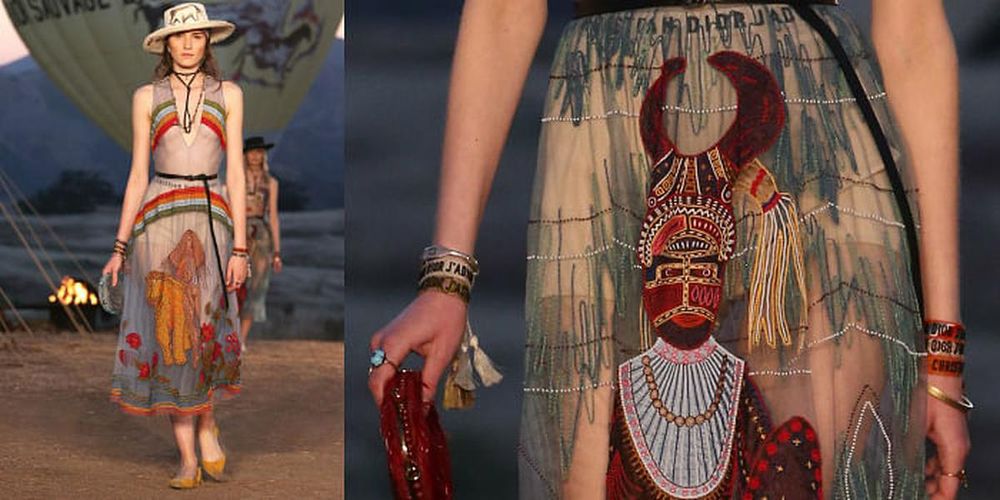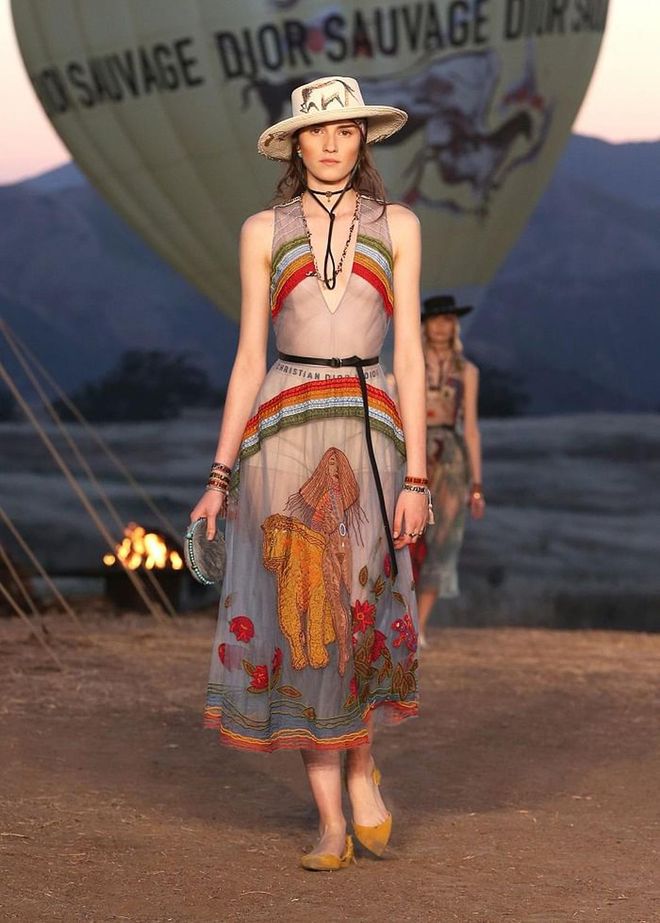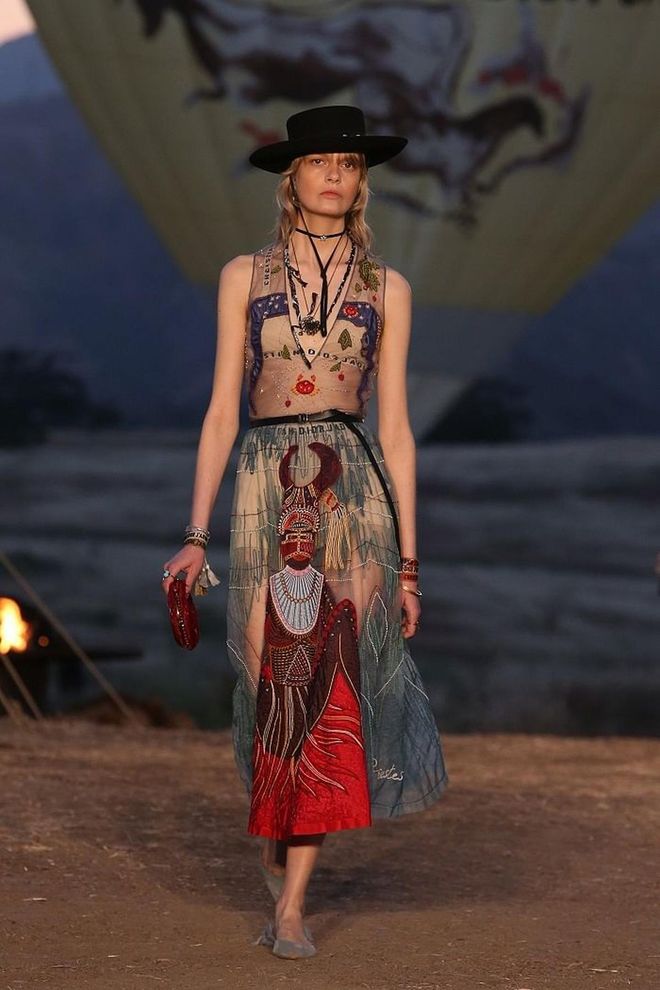Dior's Maria Grazia Chiuri Explains Our Obsession With Tarot Cards
Dior's creative director talks to us about the power and importance of a growing phenomenon


Photo: Dior
Dior
Tarot cards are making a big comeback and Dior was first to the party.
Over the past 12 months, sales of tarot cards increased by 30 percent, following a 30 percent rise in 2016, the highest in 50 years, according to Lynn Araujo, the editorial and communications director for U.S Games Systems, which sells hundreds of thousands of the product every year.
Tarot has always held a special place for the house of Dior. The brand’s eponymous founder was deeply superstitious and is said to have had his cards read before each show. Dior’s current creative director, Maria Grazia Chiuri, has woven elements of the tarot into various shows, but it was perhaps most pervasive in her cruise 2018 collection, in which she incorporated images of Motherpeace’s feminist tarot cards on numerous looks. Dior has also opened a number of international pop-up stores where the beautiful illustrations will be on display, alongside pieces from the themed collection.
So what is the appeal of tarot cards and why are we so drawn to them now? Maria Grazia Chiuri explains the importance and power of a growing phenomenon.
Why are tarot cards so important to you this season?
I have explored tarot cards in various collections, their iconography and symbolism. Tarot cards were something that fascinated Monsieur Dior, a material object evoking a spiritual world, and this is why they took root in my imagination. For this collection, I was interested in the work of Niki de Saint Phalle, an extraordinary artist who used the tarot as the inspiration for developing one of her most remarkable works: the Tarot Garden in Tuscany, Italy. A magical place inhabited by huge and fantastical figures, it conditioned my vision and my design choices for this collection.
Studying the tarot cards, I realised that today tarot is associated with occultism, but actually its historical origin lies in a game that unites East and West, and their current iconography is the result of this overlapping and juxtaposition of different cultures. Tarot cards also symbolise bonds - decks were often commissioned from artists for weddings and unions - and stories of life and rebirth. I think of the tarots of Vicki Noble, an artist who created a deck that in itself represents their rebirth into a new life. These are the lesser known aspects that I want to recover.
How superstitious are you? Have you used tarot cards or a clairvoyant personally?
I have never been to a clairvoyant myself. I believe in the possibility that each of us has to define our own future through our choices and our daily work. I'm not interested in knowing the future through the cards. What fascinates me about tarot is the role it can play in exploring one's inner self, and enabling us to learn more about the remotest parts of ourselves.

Photo: Dior
Dior
Has a tarot card ever revealed something about you that particularly resonated with you?
Although I have never participated in a card reading session, I am interested in the meaning that each card assumes, which changes continuously, in relation to the other cards. One of the works on show at the last Venice Art Biennale by artist Adelita Husni-Bey was also focused on the use of tarot as a tool to investigate one's spiritual bonds. All the cards bear positive and negative forces, there is no one reading, and keeping opposites together is something that’s very important, especially in today's world, where events happen with extreme speed, and we are often led to judge things without looking at them from all points of view.
Let’s consider the death card, for example: it’s a scary card, which apparently indicates the end of something. In reality it is an extremely important card because at the very end it communicates the opening, the possibility of renewal, of rebirth. Another interesting card, for example, is the wheel of fortune because it is an allegory of life: sublime uncertainty, but also daily curiosity about new discoveries.
What are the benefits of using them?
I believe that people who turn to tarot do so to be reassured and comforted. Even without believing in divination, 'playing' with tarot cards is a wonderful and fascinating way to investigate the deepest parts of our ego. There is always a transcendent force insinuating itself into our daily life, and that influences us without our being aware of it. My tarot reading is spiritual: I think tarots are useful for getting in tune with our 'inner life', putting it in communion with the greater themes of human existence. In this way, tarots help us in transcending our everyday life and allow us to open our eyes and become better aware of what is happening around us.

Photo: Dior
Dior
In tarot, there seems to be equal importance between men and women. Is this important to you?
The male and female figures of the tarot have very precise roles, but in the deck they balance very well: in this the tarot is a symbol of equality. Understanding that each card has a particular character, linked to the figure it represents, was very important for me, to identify the most interesting arcana to express my ideas. For example, the lovers card, which depicts a female and a male figure together, shows that love, as a force that ‘moves the sun and the other stars’ — as Dante Alighieri rightly wrote at the end of The Divine Comedy — doesn’t differentiate between man and woman, but rather considers them equal and both fundamental to understanding this force in the real world.

Photo: Dior
Dior
Why do you think tarot cards are so popular now?
I don’t know the precise reason, but it is interesting that people sometimes decide to learn to read the tarot by themselves. For me, this is a sign that many want to symbolically take their destiny back into their own hands, and in this way learn to get to know themselves better, also accepting those parts that are not immediately visible and understandable. I think it’s a way to get in touch with our most hidden aspects.

Photo: Dior
Dior
This article originally appeared on Harper's BAZAAR UK.